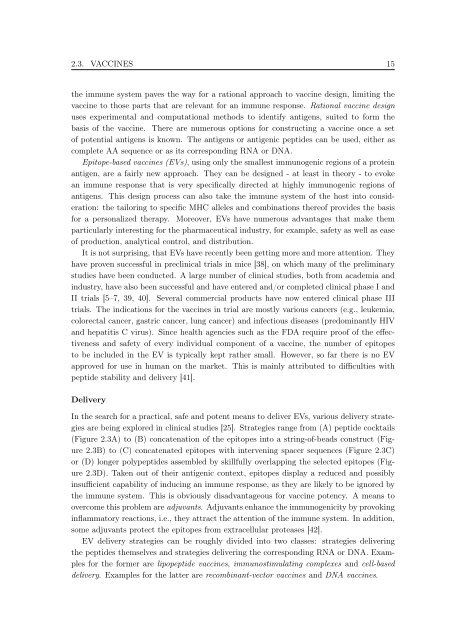New Approaches to in silico Design of Epitope-Based Vaccines
New Approaches to in silico Design of Epitope-Based Vaccines
New Approaches to in silico Design of Epitope-Based Vaccines
Create successful ePaper yourself
Turn your PDF publications into a flip-book with our unique Google optimized e-Paper software.
2.3. VACCINES 15<br />
the immune system paves the way for a rational approach <strong>to</strong> vacc<strong>in</strong>e design, limit<strong>in</strong>g the<br />
vacc<strong>in</strong>e <strong>to</strong> those parts that are relevant for an immune response. Rational vacc<strong>in</strong>e design<br />
uses experimental and computational methods <strong>to</strong> identify antigens, suited <strong>to</strong> form the<br />
basis <strong>of</strong> the vacc<strong>in</strong>e. There are numerous options for construct<strong>in</strong>g a vacc<strong>in</strong>e once a set<br />
<strong>of</strong> potential antigens is known. The antigens or antigenic peptides can be used, either as<br />
complete AA sequence or as its correspond<strong>in</strong>g RNA or DNA.<br />
Epi<strong>to</strong>pe-based vacc<strong>in</strong>es (EVs), us<strong>in</strong>g only the smallest immunogenic regions <strong>of</strong> a prote<strong>in</strong><br />
antigen, are a fairly new approach. They can be designed - at least <strong>in</strong> theory - <strong>to</strong> evoke<br />
an immune response that is very specifically directed at highly immunogenic regions <strong>of</strong><br />
antigens. This design process can also take the immune system <strong>of</strong> the host <strong>in</strong><strong>to</strong> consideration:<br />
the tailor<strong>in</strong>g <strong>to</strong> specific MHC alleles and comb<strong>in</strong>ations there<strong>of</strong> provides the basis<br />
for a personalized therapy. Moreover, EVs have numerous advantages that make them<br />
particularly <strong>in</strong>terest<strong>in</strong>g for the pharmaceutical <strong>in</strong>dustry, for example, safety as well as ease<br />
<strong>of</strong> production, analytical control, and distribution.<br />
It is not surpris<strong>in</strong>g, that EVs have recently been gett<strong>in</strong>g more and more attention. They<br />
have proven successful <strong>in</strong> precl<strong>in</strong>ical trials <strong>in</strong> mice [38], on which many <strong>of</strong> the prelim<strong>in</strong>ary<br />
studies have been conducted. A large number <strong>of</strong> cl<strong>in</strong>ical studies, both from academia and<br />
<strong>in</strong>dustry, have also been successful and have entered and/or completed cl<strong>in</strong>ical phase I and<br />
II trials [5–7, 39, 40]. Several commercial products have now entered cl<strong>in</strong>ical phase III<br />
trials. The <strong>in</strong>dications for the vacc<strong>in</strong>es <strong>in</strong> trial are mostly various cancers (e.g., leukemia,<br />
colorectal cancer, gastric cancer, lung cancer) and <strong>in</strong>fectious diseases (predom<strong>in</strong>antly HIV<br />
and hepatitis C virus). S<strong>in</strong>ce health agencies such as the FDA require pro<strong>of</strong> <strong>of</strong> the effectiveness<br />
and safety <strong>of</strong> every <strong>in</strong>dividual component <strong>of</strong> a vacc<strong>in</strong>e, the number <strong>of</strong> epi<strong>to</strong>pes<br />
<strong>to</strong> be <strong>in</strong>cluded <strong>in</strong> the EV is typically kept rather small. However, so far there is no EV<br />
approved for use <strong>in</strong> human on the market. This is ma<strong>in</strong>ly attributed <strong>to</strong> difficulties with<br />
peptide stability and delivery [41].<br />
Delivery<br />
In the search for a practical, safe and potent means <strong>to</strong> deliver EVs, various delivery strategies<br />
are be<strong>in</strong>g explored <strong>in</strong> cl<strong>in</strong>ical studies [25]. Strategies range from (A) peptide cocktails<br />
(Figure 2.3A) <strong>to</strong> (B) concatenation <strong>of</strong> the epi<strong>to</strong>pes <strong>in</strong><strong>to</strong> a str<strong>in</strong>g-<strong>of</strong>-beads construct (Figure<br />
2.3B) <strong>to</strong> (C) concatenated epi<strong>to</strong>pes with <strong>in</strong>terven<strong>in</strong>g spacer sequences (Figure 2.3C)<br />
or (D) longer polypeptides assembled by skillfully overlapp<strong>in</strong>g the selected epi<strong>to</strong>pes (Figure<br />
2.3D). Taken out <strong>of</strong> their antigenic context, epi<strong>to</strong>pes display a reduced and possibly<br />
<strong>in</strong>sufficient capability <strong>of</strong> <strong>in</strong>duc<strong>in</strong>g an immune response, as they are likely <strong>to</strong> be ignored by<br />
the immune system. This is obviously disadvantageous for vacc<strong>in</strong>e potency. A means <strong>to</strong><br />
overcome this problem are adjuvants. Adjuvants enhance the immunogenicity by provok<strong>in</strong>g<br />
<strong>in</strong>flamma<strong>to</strong>ry reactions, i.e., they attract the attention <strong>of</strong> the immune system. In addition,<br />
some adjuvants protect the epi<strong>to</strong>pes from extracellular proteases [42].<br />
EV delivery strategies can be roughly divided <strong>in</strong><strong>to</strong> two classes: strategies deliver<strong>in</strong>g<br />
the peptides themselves and strategies deliver<strong>in</strong>g the correspond<strong>in</strong>g RNA or DNA. Examples<br />
for the former are lipopeptide vacc<strong>in</strong>es, immunostimulat<strong>in</strong>g complexes and cell-based<br />
delivery. Examples for the latter are recomb<strong>in</strong>ant-vec<strong>to</strong>r vacc<strong>in</strong>es and DNA vacc<strong>in</strong>es.

















